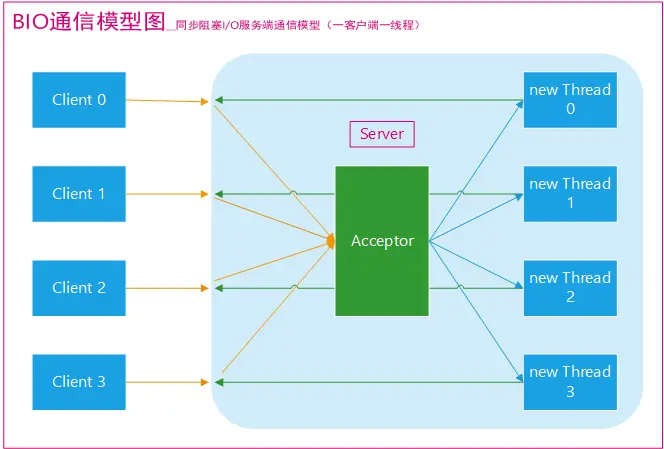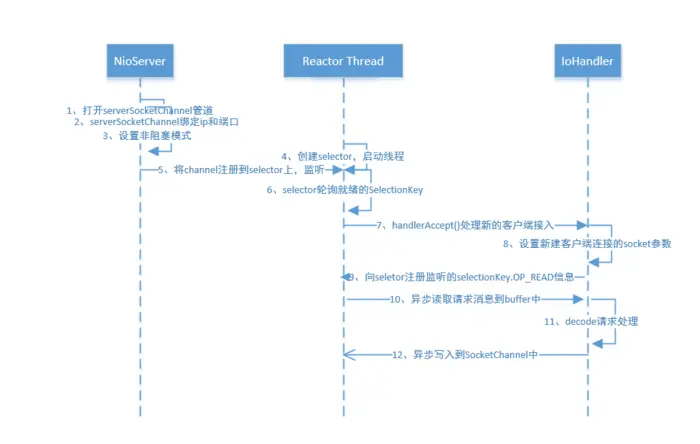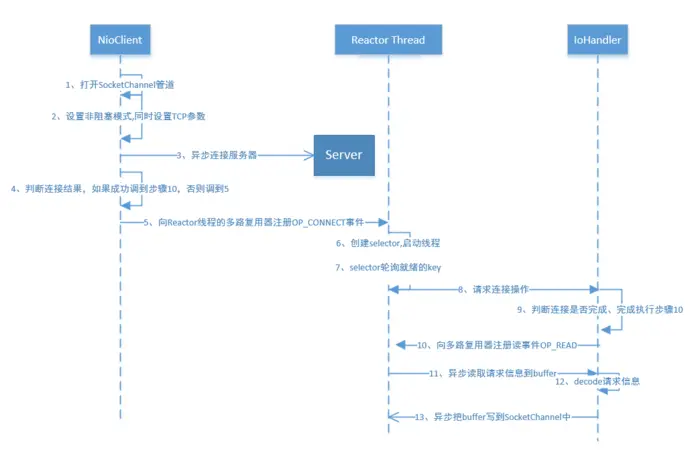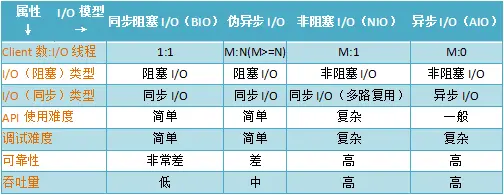Java中BIO、NIO、AIO的原理及其区别
程序员文章站
2022-07-10 16:23:24
...
IO的处理方式通常分为几种,同步阻塞的BIO、同步非阻塞的NIO、异步非阻塞的AIO。
java中IO的主要来源是本地和网络传输。
在了解三种处理方式之前,先了解,同步异步,阻塞非阻塞:
1、同步: 用户进程触发IO操作并等待或者轮询的去查看IO操作是否就绪; 例如自己亲自去 餐厅吃饭
2、异步: 用户触发IO操作以后,可以干别的事,IO操作完成以后再通知当前线程;例如自己通过美团外卖订购了,送餐上面;自己在等餐到来时间可以干别的事情;
3、阻塞: 当试图进读写文件的时候,发现不可读取或没东西读,则进入等待状态知道可读;例如去楼下排队等餐;
4、非阻塞:用户进程访问数据时,会马上返回一个状态值(可读不可读);例如在餐厅吃饭,先取个号,然后坐着等待服务员报号才能入座吃饭(你可以不停的询问服务员还有多久)。(使用非阻塞IO时,如果不能读写Java调用会马上返回,当IO事件分发器会通知可读写时再继续进行读写,不断循环直到读写完成)。
一、同步阻塞BIO
在JDK1.4出来之前,我们建立网络连接的时候采用BIO模式,需要先在服务端启动一个ServerSocket,然后在客户端启动Socket来对服务端进行通信,默认情况下服务端需要对每个请求建立一堆线程等待请求,而客户端发送请求后,先咨询服务端是否有线程相应,如果没有则会一直等待或者遭到拒绝请求,如果有的话,客户端会线程会等待请求结束后才继续执行。

该模型最大的问题就是缺乏弹性伸缩能力,当客户端并发访问量增加后,服务端的线程个数和客户端并发访问数呈1:1的正比关系,Java中的线程也是比较宝贵的系统资源,线程数量快速膨胀后,系统的性能将急剧下降,随着访问量的继续增大,系统最终就死掉了。不适合高并发和高性能方面。
二、同步非阻塞的NIO
NIO详细文档:http://ifeve.com/java-nio-all/
JDK 1.4中的java.nio.*包中引入新的Java I/O库,其目的是提高速度。实际上,“旧”的I/O包已经使用NIO重新实现过,即使我们不显式的使用NIO编程,也能从中受益。
NIO我们一般认为是New I/O(也是官方的叫法),因为它是相对于老的I/O类库新增的(其实在JDK 1.4中就已经被引入了,但这个名词还会继续用很久,即使它们在现在看来已经是“旧”的了,所以也提示我们在命名时,需要好好考虑),做了很大的改变。但民间跟多人称之为Non-block I/O,即非阻塞I/O,因为这样叫,更能体现它的特点。而下文中的NIO,不是指整个新的I/O库,而是非阻塞I/O。
NIO提供了与传统BIO模型中的Socket和ServerSocket相对应的SocketChannel和ServerSocketChannel两种不同的套接字通道实现。
新增的着两种通道都支持阻塞和非阻塞两种模式。
阻塞模式使用就像传统中的支持一样,比较简单,但是性能和可靠性都不好;非阻塞模式正好与之相反。
对于低负载、低并发的应用程序,可以使用同步阻塞I/O来提升开发速率和更好的维护性;对于高负载、高并发的(网络)应用,应使用NIO的非阻塞模式来开发。
服务端流程图:

客户端流程图:

客户端代码:
服务端代码:
测试代码:
三、异步非阻塞AIO
NIO 2.0引入了新的异步通道的概念,并提供了异步文件通道和异步套接字通道的实现。
异步的套接字通道时真正的异步非阻塞I/O,对应于UNIX网络编程中的事件驱动I/O(AIO)。他不需要过多的Selector对注册的通道进行轮询即可实现异步读写,从而简化了NIO的编程模型。
客户端代码:
服务端代码:
各种I/O的对比:

BIO、NIO、AIO适用场景分析:
BIO方式适用于连接数目比较小且固定的架构,这种方式对服务器资源要求比较高,并发局限于应用中,JDK1.4以前的唯一选择,但程序直观简单易理解。
NIO方式适用于连接数目多且连接比较短(轻操作)的架构,比如聊天服务器,并发局限于应用中,编程比较复杂,JDK1.4开始支持。
AIO方式使用于连接数目多且连接比较长(重操作)的架构,比如相册服务器,充分调用OS参与并发操作,编程比较复杂,JDK7开始支持。
另外,I/O属于底层操作,需要操作系统支持,并发也需要操作系统的支持,所以性能方面不同操作系统差异会比较明显。
java中IO的主要来源是本地和网络传输。
在了解三种处理方式之前,先了解,同步异步,阻塞非阻塞:
1、同步: 用户进程触发IO操作并等待或者轮询的去查看IO操作是否就绪; 例如自己亲自去 餐厅吃饭
2、异步: 用户触发IO操作以后,可以干别的事,IO操作完成以后再通知当前线程;例如自己通过美团外卖订购了,送餐上面;自己在等餐到来时间可以干别的事情;
3、阻塞: 当试图进读写文件的时候,发现不可读取或没东西读,则进入等待状态知道可读;例如去楼下排队等餐;
4、非阻塞:用户进程访问数据时,会马上返回一个状态值(可读不可读);例如在餐厅吃饭,先取个号,然后坐着等待服务员报号才能入座吃饭(你可以不停的询问服务员还有多久)。(使用非阻塞IO时,如果不能读写Java调用会马上返回,当IO事件分发器会通知可读写时再继续进行读写,不断循环直到读写完成)。
一、同步阻塞BIO
在JDK1.4出来之前,我们建立网络连接的时候采用BIO模式,需要先在服务端启动一个ServerSocket,然后在客户端启动Socket来对服务端进行通信,默认情况下服务端需要对每个请求建立一堆线程等待请求,而客户端发送请求后,先咨询服务端是否有线程相应,如果没有则会一直等待或者遭到拒绝请求,如果有的话,客户端会线程会等待请求结束后才继续执行。
该模型最大的问题就是缺乏弹性伸缩能力,当客户端并发访问量增加后,服务端的线程个数和客户端并发访问数呈1:1的正比关系,Java中的线程也是比较宝贵的系统资源,线程数量快速膨胀后,系统的性能将急剧下降,随着访问量的继续增大,系统最终就死掉了。不适合高并发和高性能方面。
二、同步非阻塞的NIO
NIO详细文档:http://ifeve.com/java-nio-all/
JDK 1.4中的java.nio.*包中引入新的Java I/O库,其目的是提高速度。实际上,“旧”的I/O包已经使用NIO重新实现过,即使我们不显式的使用NIO编程,也能从中受益。
NIO我们一般认为是New I/O(也是官方的叫法),因为它是相对于老的I/O类库新增的(其实在JDK 1.4中就已经被引入了,但这个名词还会继续用很久,即使它们在现在看来已经是“旧”的了,所以也提示我们在命名时,需要好好考虑),做了很大的改变。但民间跟多人称之为Non-block I/O,即非阻塞I/O,因为这样叫,更能体现它的特点。而下文中的NIO,不是指整个新的I/O库,而是非阻塞I/O。
NIO提供了与传统BIO模型中的Socket和ServerSocket相对应的SocketChannel和ServerSocketChannel两种不同的套接字通道实现。
新增的着两种通道都支持阻塞和非阻塞两种模式。
阻塞模式使用就像传统中的支持一样,比较简单,但是性能和可靠性都不好;非阻塞模式正好与之相反。
对于低负载、低并发的应用程序,可以使用同步阻塞I/O来提升开发速率和更好的维护性;对于高负载、高并发的(网络)应用,应使用NIO的非阻塞模式来开发。
服务端流程图:
客户端流程图:
客户端代码:
package com.example.demo.aio;
import java.io.IOException;
import java.net.InetSocketAddress;
import java.nio.ByteBuffer;
import java.nio.channels.SelectionKey;
import java.nio.channels.Selector;
import java.nio.channels.SocketChannel;
import java.util.Iterator;
import java.util.Set;
/**
* Created with IntelliJ IDEA.
* User: 简德群
* Date: 2018/3/12
* Time: 18:15
* To change this template use File | Settings | File Templates.
*/
public class NioClient implements Runnable{
private String ip;
private int port;
private Selector selector;
private SocketChannel socketChannel;
private volatile boolean started;
public NioClient(String ip,int port){
this.ip=ip;
this.port=port;
try {
//创建选择器
selector =Selector.open();
//打开监听端口
socketChannel = SocketChannel.open(new InetSocketAddress(ip,port));
socketChannel.configureBlocking(false);//设置非阻塞模式
started = true;
} catch (IOException e) {
e.printStackTrace();
System.exit(1);
}
}
public void stop(){
this.started = false;
}
@Override
public void run() {
//连接服务器
try {
doConnect();
} catch (IOException e) {
e.printStackTrace();
System.exit(1);
}
//循环遍历selector
while (started) {
try {
//无论是否有读写事件发生,selector每隔1s被唤醒一次
selector.select(1000);
//阻塞,只有当至少一个注册的事件发生的时候才会继续.
// selector.select();
Set<SelectionKey> keys = selector.selectedKeys();
Iterator<SelectionKey> it = keys.iterator();
SelectionKey key = null;
while (it.hasNext()) {
key = it.next();
it.remove();
try {
handleInput(key);
} catch (Exception e) {
if (key != null) {
key.cancel();
if (key.channel() != null) {
key.channel().close();
}
}
}
}
} catch (Exception e) {
e.printStackTrace();
System.exit(1);
}
}
//selector关闭后会自动释放里面管理的资源
if (selector != null)
try {
selector.close();
} catch (Exception e) {
e.printStackTrace();
}
}
private void handleInput(SelectionKey key) throws IOException {
if(key.isValid()){
SocketChannel sc = (SocketChannel) key.channel();
if(key.isConnectable()){
if(sc.finishConnect());
else System.exit(1);
}
//读消息
if(key.isReadable()){
//创建ByteBuffer,并开辟一个1M的缓冲区
ByteBuffer buffer = ByteBuffer.allocate(1024);
//读取请求码流,返回读取到的字节数
int readBytes = sc.read(buffer);
//读取到字节,对字节进行编解码
if(readBytes>0){
//将缓冲区当前的limit设置为position=0,用于后续对缓冲区的读取操作
buffer.flip();
//根据缓冲区可读字节数创建字节数组
byte[] bytes = new byte[buffer.remaining()];
//将缓冲区可读字节数组复制到新建的数组中
buffer.get(bytes);
String result = new String(bytes,"UTF-8");
System.out.println("客户端收到消息:" + result);
}
//没有读取到字节 忽略
// else if(readBytes==0);
//链路已经关闭,释放资源
else if(readBytes<0){
key.cancel();
sc.close();
}
}
}
}
private void doConnect() throws IOException {
if(socketChannel.connect(new InetSocketAddress(this.ip,this.port)));
else socketChannel.register(selector, SelectionKey.OP_CONNECT);
}
public void sendMsg(String message) throws IOException {
socketChannel.register(selector,SelectionKey.OP_READ);
doWrite(socketChannel,message);
}
//异步发送消息
private void doWrite(SocketChannel channel,String request) throws IOException{
//将消息编码为字节数组
byte[] bytes = request.getBytes();
//根据数组容量创建ByteBuffer
ByteBuffer writeBuffer = ByteBuffer.allocate(bytes.length);
//将字节数组复制到缓冲区
writeBuffer.put(bytes);
//flip操作
writeBuffer.flip();
//发送缓冲区的字节数组
channel.write(writeBuffer);
//****此处不含处理“写半包”的代码
}
}
package com.example.demo.aio;
/**
* Created with IntelliJ IDEA.
* User: 简德群
* Date: 2018/3/13
* Time: 9:13
* To change this template use File | Settings | File Templates.
*/
public class RunClient {
private final static int DEFUALT_PORT=12345;
private final static String SERVER_IP="127.0.0.1";
private static NioClient nioClient;
public static void start(){
start(DEFUALT_PORT,SERVER_IP);
}
public synchronized static void start(int port,String ip){
if(nioClient!=null)
nioClient.stop();
nioClient = new NioClient(ip,port);
new Thread(nioClient,"client").start();
}
//向服务器发送消息
public static boolean sendMsg(String msg) throws Exception{
if(msg.equals("q")) return false;
nioClient.sendMsg(msg);
return true;
}
public static void main(String[] args){
start();
}
}
服务端代码:
package com.example.demo.aio;
import java.io.IOException;
import java.net.InetSocketAddress;
import java.nio.ByteBuffer;
import java.nio.channels.SelectionKey;
import java.nio.channels.Selector;
import java.nio.channels.ServerSocketChannel;
import java.nio.channels.SocketChannel;
import java.util.Iterator;
import java.util.Set;
/**
* Created with IntelliJ IDEA.
* User: 简德群
* Date: 2018/3/12
* Time: 17:42
* To change this template use File | Settings | File Templates.
*/
public class NioServer implements Runnable {
private Selector selector;
private ServerSocketChannel serverSocketChannel;
private volatile boolean started;
public NioServer(int port) throws IOException {
//指定选择器
selector = Selector.open();
//打开监听通道
serverSocketChannel = ServerSocketChannel.open();
//设置监听通道是否为阻塞(true)/非阻塞(false)
serverSocketChannel.configureBlocking(false); //开启非阻塞模式
//绑定端口, backlog设为1024
serverSocketChannel.socket().bind(new InetSocketAddress(port),1024);
//监听客户端连接请求
serverSocketChannel.register(selector, SelectionKey.OP_ACCEPT);
//标记服务器开启
started = true;
System.out.println("AioServer.AioServer已开启端口:"+port);
}
public void stop(){
started =false;
}
@Override
public void run() {
//如果服务器开启
while(started){
//循环变量selector
try {
//无论是否有读写事件发生,selector每隔1s被唤醒一次
selector.select(1000);
//阻塞,只有当至少一个注册的事件发生的时候才会继续.
// selector.select();
Set<SelectionKey> set = selector.selectedKeys();
Iterator<SelectionKey> iterator = set.iterator();
SelectionKey key = null;
while(iterator.hasNext()){
key = iterator.next();
iterator.remove();;
handleInputSelectionKey(key);
}
} catch (IOException e) {
e.printStackTrace();
}
}
}
public void handleInputSelectionKey(SelectionKey key) throws IOException {
if(key.isValid()){
//处理新接入的请求信息
if(key.isAcceptable()){
ServerSocketChannel ssc = (ServerSocketChannel) key.channel();
//通过ServerSocketChannel的accept创建SocketChannel实例
//完成该操作意味着完成TCP三次握手,TCP物理链路正式建立
SocketChannel sc = ssc.accept();
sc.configureBlocking(false);//设置为非阻塞
//注册为读
sc.register(selector, SelectionKey.OP_READ);
}
//读消息
if(key.isReadable()){
SocketChannel sc = (SocketChannel) key.channel();
//创建ByteBuffer,并开辟一个1M的缓冲区
ByteBuffer byteBuffer = ByteBuffer.allocate(1024);
////读取请求码流,返回读取到的字节数
int readbytes = sc.read(byteBuffer);
//读取到字节,对字节进行编解码
if(readbytes >0){
//将缓冲区当前的limit设置为position=0,用于后续对缓冲区的读取操作
byteBuffer.flip();
//根据缓冲区可读字节数创建字节数组
byte[] bytes = new byte[byteBuffer.remaining()];
//将缓冲区可读字节数组复制到新建的数组中
byteBuffer.get(bytes);
String msg = new String(bytes,"UTF-8");
System.out.println("服务器收到消息:" + msg);
//发送应答消息
String result = "收到"+msg;
doWrite(sc,msg);
}
//没有读取到字节 忽略
// else if(readBytes==0);
//链路已经关闭,释放资源
else if(readbytes<0){
key.cancel();
sc.close();
}
}
}
}
//异步发送应答消息
private void doWrite(SocketChannel channel,String response) throws IOException{
//将消息编码为字节数组
byte[] bytes = response.getBytes();
//根据数组容量创建ByteBuffer
ByteBuffer writeBuffer = ByteBuffer.allocate(bytes.length);
//将字节数组复制到缓冲区
writeBuffer.put(bytes);
//flip操作
writeBuffer.flip();
//发送缓冲区的字节数组
channel.write(writeBuffer);
//****此处不含处理“写半包”的代码
}
}
package com.example.demo.aio;
import java.io.IOException;
/**
* Created with IntelliJ IDEA.
* User: 简德群
* Date: 2018/3/12
* Time: 18:12
* To change this template use File | Settings | File Templates.
*/
public class RunServer {
private final static int PORT = 12345;
private static NioServer nioServer;
public static void start(){
start(PORT);
}
public static synchronized void start(int port){
if(aioServer!=null)
nioServer.stop();
try {
nioServer = new NioServer(port);
} catch (IOException e) {
e.printStackTrace();
}
new Thread(nioServer,"Server").start();
}
public static void main(String[] args){
start();
}
}
测试代码:
package com.example.demo.aio;
/**
* Created with IntelliJ IDEA.
* User: 简德群
* Date: 2018/3/13
* Time: 10:07
* To change this template use File | Settings | File Templates.
*/
public class NioTest {
public static void main(String[] args) throws Exception {
RunServer.start();
Thread.sleep(1000);
RunClient.start();
RunClient.sendMsg("jsjsj");
// while (RunClient.sendMsg(new Scanner(System.in).nextLine()));
}
}
三、异步非阻塞AIO
NIO 2.0引入了新的异步通道的概念,并提供了异步文件通道和异步套接字通道的实现。
异步的套接字通道时真正的异步非阻塞I/O,对应于UNIX网络编程中的事件驱动I/O(AIO)。他不需要过多的Selector对注册的通道进行轮询即可实现异步读写,从而简化了NIO的编程模型。
客户端代码:
package com.example.demo.aio;
import java.io.IOException;
import java.io.UnsupportedEncodingException;
import java.net.InetSocketAddress;
import java.nio.ByteBuffer;
import java.nio.channels.AsynchronousSocketChannel;
import java.nio.channels.CompletionHandler;
import java.util.concurrent.CountDownLatch;
/**
* Created with IntelliJ IDEA.
* User: 简德群
* Date: 2018/3/12
* Time: 18:15
* To change this template use File | Settings | File Templates.
*/
public class AioClient implements CompletionHandler<Void, AioClient>, Runnable{
private String ip;
private int port;
private AsynchronousSocketChannel asynchronousSocketChannel;
private CountDownLatch latch;
public AioClient(String ip,int port){
this.ip=ip;
this.port=port;
try {
//创建异步的客户端通道
asynchronousSocketChannel = AsynchronousSocketChannel.open();
} catch (IOException e) {
e.printStackTrace();
}
}
public void run() {
//创建CountDownLatch等待
latch = new CountDownLatch(1);
//发起异步连接操作,回调参数就是这个类本身,如果连接成功会回调completed方法
asynchronousSocketChannel.connect(new InetSocketAddress(ip, port), this, this);
try {
latch.await();
} catch (InterruptedException e1) {
e1.printStackTrace();
}
try {
asynchronousSocketChannel.close();
} catch (IOException e) {
e.printStackTrace();
}
}
//连接服务器成功
//意味着TCP三次握手完成
public void completed(Void result, AioClient attachment) {
System.out.println("客户端成功连接到服务器...");
}
//连接服务器失败
public void failed(Throwable exc, AioClient attachment) {
System.err.println("连接服务器失败...");
exc.printStackTrace();
try {
asynchronousSocketChannel.close();
latch.countDown();
} catch (IOException e) {
e.printStackTrace();
}
}
//向服务器发送消息
public void sendMsg(String msg){
byte[] req = msg.getBytes();
ByteBuffer writeBuffer = ByteBuffer.allocate(req.length);
writeBuffer.put(req);
writeBuffer.flip();
//异步写
asynchronousSocketChannel.write(writeBuffer, writeBuffer,new WriteHandler(asynchronousSocketChannel, latch));
}
}
class WriteHandler implements CompletionHandler<Integer, ByteBuffer> {
private AsynchronousSocketChannel clientChannel;
private CountDownLatch latch;
public WriteHandler(AsynchronousSocketChannel clientChannel,CountDownLatch latch) {
this.clientChannel = clientChannel;
this.latch = latch;
}
public void completed(Integer result, ByteBuffer buffer) {
//完成全部数据的写入
if (buffer.hasRemaining()) {
clientChannel.write(buffer, buffer, this);
}
else {
//读取数据
ByteBuffer readBuffer = ByteBuffer.allocate(1024);
clientChannel.read(readBuffer,readBuffer,new ReadClientHandler(clientChannel, latch));
}
}
public void failed(Throwable exc, ByteBuffer attachment) {
System.err.println("数据发送失败...");
try {
clientChannel.close();
latch.countDown();
} catch (IOException e) {
}
}
}
class ReadClientHandler implements CompletionHandler<Integer, ByteBuffer> {
private AsynchronousSocketChannel clientChannel;
private CountDownLatch latch;
public ReadClientHandler(AsynchronousSocketChannel clientChannel,CountDownLatch latch) {
this.clientChannel = clientChannel;
this.latch = latch;
}
@Override
public void completed(Integer result,ByteBuffer buffer) {
buffer.flip();
byte[] bytes = new byte[buffer.remaining()];
buffer.get(bytes);
String body;
try {
body = new String(bytes,"UTF-8");
System.out.println("客户端收到结果:"+ body);
} catch (UnsupportedEncodingException e) {
e.printStackTrace();
}
}
@Override
public void failed(Throwable exc,ByteBuffer attachment) {
System.err.println("数据读取失败...");
try {
clientChannel.close();
latch.countDown();
} catch (IOException e) {
}
}
}
package com.example.demo.aio;
/**
* Created with IntelliJ IDEA.
* User: 简德群
* Date: 2018/3/13
* Time: 9:13
* To change this template use File | Settings | File Templates.
*/
public class RunClient {
private final static int DEFUALT_PORT=12345;
private final static String SERVER_IP="127.0.0.1";
private static AioClient aioClient;
public static void start(){
start(DEFUALT_PORT,SERVER_IP);
}
public synchronized static void start(int port,String ip){
if(aioClient==null){
aioClient = new AioClient(ip,port);
new Thread(aioClient,"client").start();
}
}
//向服务器发送消息
public static boolean sendMsg(String msg) throws Exception{
if(msg.equals("q")) return false;
aioClient.sendMsg(msg);
return true;
}
public static void main(String[] args){
start();
}
}
服务端代码:
package com.example.demo.aio;
import java.io.IOException;
import java.net.InetSocketAddress;
import java.nio.channels.AsynchronousServerSocketChannel;
import java.util.concurrent.CountDownLatch;
/**
* Created with IntelliJ IDEA.
* User: 简德群
* Date: 2018/3/12
* Time: 17:42
* To change this template use File | Settings | File Templates.
*/
public class AioServer implements Runnable {
public CountDownLatch latch;
public AsynchronousServerSocketChannel asynchronousServerSocketChannel;
public AioServer(int port) throws IOException {
//创建服务通道
asynchronousServerSocketChannel = AsynchronousServerSocketChannel.open();
//绑定端口
asynchronousServerSocketChannel.bind(new InetSocketAddress(port),1024);
//标记服务器开启
System.out.println("AioServer.AioServer已开启端口:"+port);
}
public void run() {
//CountDownLatch初始化
//它的作用:在完成一组正在执行的操作之前,允许当前的现场一直阻塞
//此处,让现场在此阻塞,防止服务端执行完成后退出
//也可以使用while(true)+sleep
//生成环境就不需要担心这个问题,以为服务端是不会退出的
latch = new CountDownLatch(1);
//用于接收客户端的连接
asynchronousServerSocketChannel.accept(this,new AcceptHandler());
try {
latch.await();
} catch (InterruptedException e) {
e.printStackTrace();
}
}
}
package com.example.demo.aio;
import java.nio.ByteBuffer;
import java.nio.channels.AsynchronousSocketChannel;
import java.nio.channels.CompletionHandler;
/**
* Created with IntelliJ IDEA.
* User: 简德群
* Date: 2018/3/13
* Time: 11:35
* To change this template use File | Settings | File Templates.
*/
//作为handler接收客户端连接
public class AcceptHandler implements CompletionHandler<AsynchronousSocketChannel, AioServer> {
public void completed(AsynchronousSocketChannel channel,AioServer aioServer) {
//继续接受其他客户端的请求
RunServer.clientCount++;
System.out.println("连接的客户端数:" + RunServer.clientCount);
aioServer.asynchronousServerSocketChannel.accept(aioServer, this);
//创建新的Buffer
ByteBuffer buffer = ByteBuffer.allocate(1024);
//异步读 第三个参数为接收消息回调的业务Handler
channel.read(buffer, buffer, new ReadHandler(channel));
}
public void failed(Throwable exc, AioServer aioServer) {
exc.printStackTrace();
aioServer.latch.countDown();
}
}
package com.example.demo.aio;
import java.io.IOException;
import java.io.UnsupportedEncodingException;
import java.nio.ByteBuffer;
import java.nio.channels.AsynchronousSocketChannel;
import java.nio.channels.CompletionHandler;
/**
* Created with IntelliJ IDEA.
* User: 简德群
* Date: 2018/3/13
* Time: 11:42
* To change this template use File | Settings | File Templates.
*/
public class ReadHandler implements CompletionHandler<Integer, ByteBuffer> {
//用于读取半包消息和发送应答
private AsynchronousSocketChannel channel;
public ReadHandler(AsynchronousSocketChannel channel) {
this.channel = channel;
}
//读取到消息后的处理
public void completed(Integer result, ByteBuffer attachment) {
//flip操作
attachment.flip();
//根据
byte[] message = new byte[attachment.remaining()];
attachment.get(message);
try {
String expression = new String(message, "UTF-8");
System.out.println("服务器收到消息: " + expression);
//向客户端发送消息
doWrite("服务器发送客户端:"+expression);
} catch (UnsupportedEncodingException e) {
e.printStackTrace();
}
}
//发送消息
private void doWrite(String result) {
byte[] bytes = result.getBytes();
ByteBuffer writeBuffer = ByteBuffer.allocate(bytes.length);
writeBuffer.put(bytes);
writeBuffer.flip();
//异步写数据 参数与前面的read一样
channel.write(writeBuffer, writeBuffer,new CompletionHandler<Integer, ByteBuffer>() {
public void completed(Integer result, ByteBuffer buffer) {
//如果没有发送完,就继续发送直到完成
if (buffer.hasRemaining())
channel.write(buffer, buffer, this);
else{
//创建新的Buffer
ByteBuffer readBuffer = ByteBuffer.allocate(1024);
//异步读 第三个参数为接收消息回调的业务Handler
channel.read(readBuffer, readBuffer, new ReadHandler(channel));
}
}
public void failed(Throwable exc, ByteBuffer attachment) {
try {
channel.close();
} catch (IOException e) {
}
}
});
}
public void failed(Throwable exc, ByteBuffer attachment) {
try {
this.channel.close();
} catch (IOException e) {
e.printStackTrace();
}
}
}
package com.example.demo.aio;
import java.io.IOException;
/**
* Created with IntelliJ IDEA.
* User: 简德群
* Date: 2018/3/12
* Time: 18:12
* To change this template use File | Settings | File Templates.
*/
public class RunServer {
private final static int PORT = 12345;
private static AioServer aioServer;
public static int clientCount =0;
public static void start(){
start(PORT);
}
public static synchronized void start(int port){
if(aioServer != null){
try {
aioServer = new AioServer(port);
} catch (IOException e) {
e.printStackTrace();
}
}
new Thread(aioServer,"Server").start();
}
public static void main(String[] args){
start();
}
}
各种I/O的对比:
BIO、NIO、AIO适用场景分析:
BIO方式适用于连接数目比较小且固定的架构,这种方式对服务器资源要求比较高,并发局限于应用中,JDK1.4以前的唯一选择,但程序直观简单易理解。
NIO方式适用于连接数目多且连接比较短(轻操作)的架构,比如聊天服务器,并发局限于应用中,编程比较复杂,JDK1.4开始支持。
AIO方式使用于连接数目多且连接比较长(重操作)的架构,比如相册服务器,充分调用OS参与并发操作,编程比较复杂,JDK7开始支持。
另外,I/O属于底层操作,需要操作系统支持,并发也需要操作系统的支持,所以性能方面不同操作系统差异会比较明显。